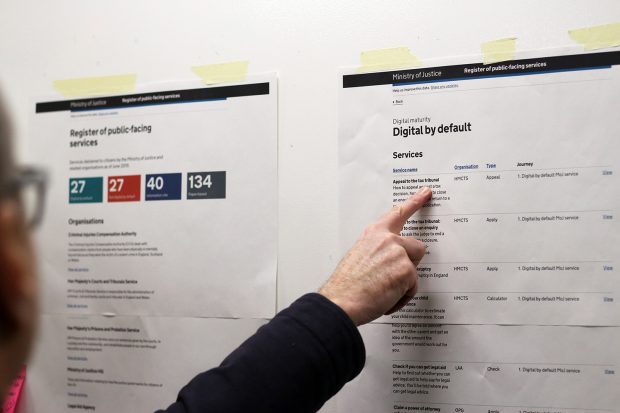
Over the past 10 years, the UK government has digitally transformed hundreds of services, such as driving a car or getting a fishing license. These services are available 24 hours a day, written in clear English, and easier to use than their non-digital predecessors. For instance, by integrating GOV.UK Pay with their service, the Ministry of Justice made it easier to send money to someone in prison or pay probate fees.
These new online services discard old paper logic and are redesigned in line with digital service and data standards. They are designed alongside offline provisions, to ensure that multi-channel delivery is in place, so people can select the most useful and simple way of interacting with government for them.
It’s important that we measure the benefits of digital transformation and show specific examples of success metrics, such as increased digital take-up, reduced processing times, and higher citizen satisfaction rates. By demonstrating the economic benefits, GDS encourages more service design teams and policymakers to promote user-centred design.
Since the 2013 exemplar programme, GDS has been measuring and showing what good looks like on individual services, and it continues to do so. In a recent piece of work, GDS collaborated with individual service teams in several government organisations to identify and document the value of their digital transformation work. This blog post marks the start of a series, which aims to document these examples and case studies of best practice and good end-to-end service design.
An end-to-end service is a service that is joined up for the user. It means that the front-end user interface is joined up with the back-end technology that underpins the service. It also means that the service allows the user to complete a whole journey – users do not need to provide duplicated information to different departments or organisations. This often involves cross-department collaboration and delivery within government.
GDS has a vision that by 2030, government will be joined up, trusted and responsive to user needs. To achieve this, services will need to solve whole user problems and be designed end-to-end. This will ensure that government services will keep pace with rising user expectations.
There are many benefits to designing end-to-end services. These benefits extend to both users and government.
Benefits to users
Time savings
People spend less time completing services as they are better designed, and digitalised from end to end. This means that people do not have to repeat steps or provide the same information more than once, resulting in less time wasted.
Simpler services
Digitalised services are easier to use. There is a greater degree of accessibility. This means that more people are able to complete transactions with government and access the services that they need.
Benefits to government
Time savings for civil servants
Digitalising services makes back-end admin and the review of processes much more efficient. This saves time for staff who no longer have to complete long and manual processes.
Multi-channel service delivery
While it is important to continue to provide a range of channels for people to interact with government for accessibility reasons, providing digitalised services allows users to move onto online channels of transaction, rather than more costly channels such as phone, email, or face-to-face.
Reduced failure demand
Digitalising services makes them easier for citizens and businesses to use and complete. This means there is less demand for support centres because most people are able to complete their transactions without further help.
Improved data quality
Digitalising services involves developing systems that are easier for people to use, more accessible and more secure. This allows for improved and consistent data collection, which can automatically be stored effectively. This subsequently enables data to be harnessed more effectively to inform decision making, reduces errors in the data held by government, and improves the security with which we hold user data.
Eliminating expensive third party (legacy) providers of technological solutions
Digitalising government and building digital capability means that we do not have to use third party providers to deliver digital services or host technical infrastructure. This reduces costs for government, and reduces dependency on legacy technology.
Given the potential benefits of end-to-end service design and delivery, there is a push in GDS to expand work of this kind. It is important to recognise that some users will prefer to continue using existing delivery channels. However, providing digital services alongside these, to ensure services are accessible across multiple channels, has the potential to generate significant benefits for government and users.
This series of blog posts will present several exemplars of end-to-end service provision across government, highlighting the problems that were overcome, the benefits of the new services, and the challenges that had to be tackled when designing these services. Where possible, we will try to value the benefits in monetary terms, but it should be noted that these are estimates based on assumptions.
Our initial case study will focus on services that have been designed by the Home Office. However, end-to-end service provision spans across the whole spectrum of government and the public sector, so we will try to cover examples from various types of government organisations. Sign up to email updates for the Services in government blog to not miss a case study.
At GDS, we are interested in this work, and in the spirit of transparent working, we are always keen to hear more. If you have any questions, thoughts or examples of your own end to end service provision, we would like to hear from you. Email us at services-in-government@digital.cabinet-office.gov.uk to get in touch.
Related blog posts:
How we support service design across government on the GDS blog
Why you should set up a service community on the GDS blog